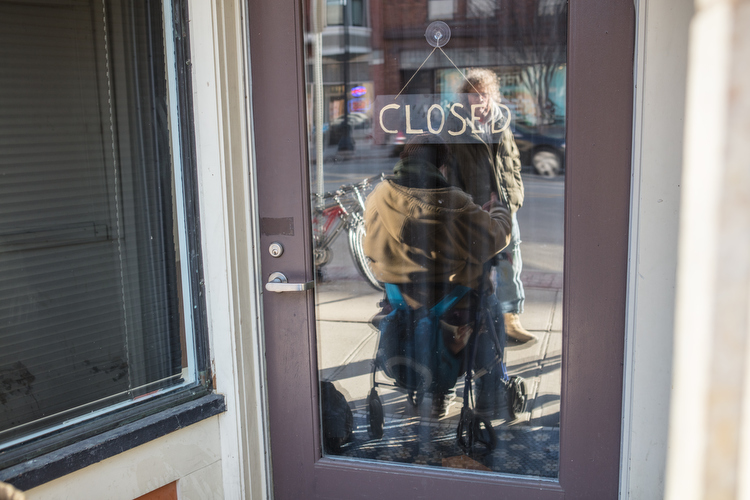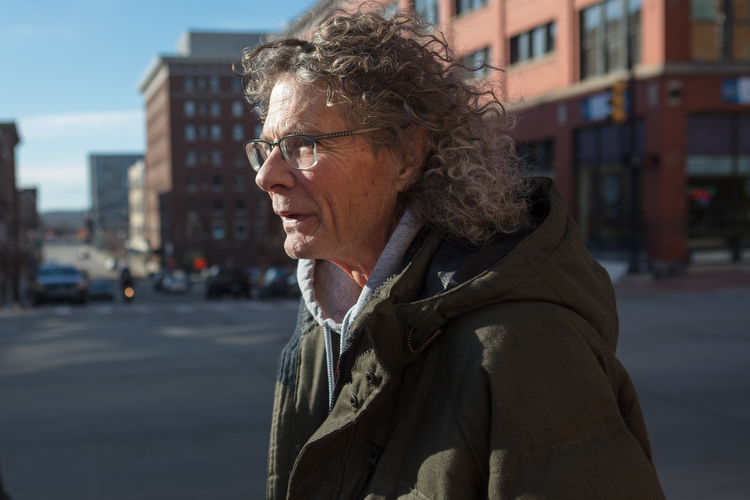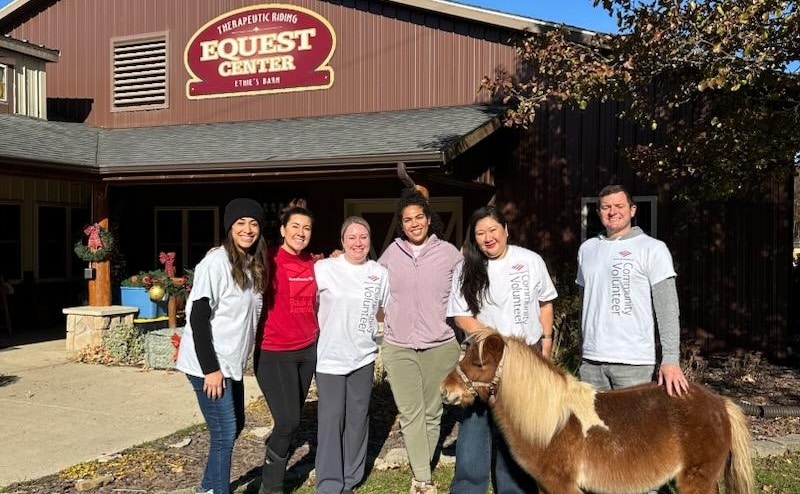Can Grand Rapids end homelessness?: Best practices and local challenges to a nationwide issue
Everyone has a different stake in “solving” the issue of homelessness in Grand Rapids. But does anyone have an accurate picture of the issue—and who we’re actually talking about when we refer to Grand Rapids’ “homeless” population? In the first of a three-part series, RG dives into homelessness in our community, exploring the complexities, discussing best practices, and defining the housing first model.

Over the last several years, it feels as if the subject of “ending homelessness” has grown to near mythic proportions within our community. And it’s easy to see why. Both in terms of the physical space taken up by our homeless, transient, and low-income neighbors, and in terms of the real estate occupied by the ministries which serve them (many in the Heartside neighborhood), it’s clear that for better or for worse, downtown’s future is linked to this population.
It’s an issue that everyone seems to have a different perspective on. Pastors; nonprofit executive directors; residents; panhandlers; Downtown Ambassadors; city leaders; business owners; and homeless individuals themselves. Everyone holds a unique viewpoint on the issue, based on specific experiences—many of which conflict with one another.
The conclusion, in short, is that the situation is complicated. Really complicated. And that we underestimate its complexity at our city’s peril—and at the peril of our most vulnerable citizens.
From ministry operators looking towards their organizations’ futures, to city leadership keeping a keen eye to “underutilized” potential for retail and tourism, to residents of market rate apartments who grow weary of panhandling: everyone has a different stake in “solving” the issue of homelessness in Grand Rapids. But does anyone have an accurate picture of what exactly the problem is—and who we’re actually talking about when we refer to Grand Rapids’ “homeless” population?
By the numbers
The most recent 2017 Point In Time (PIT) count provided by Grand Rapids Area Coalition to End Homelessness doesn’t offer much to brag about. PIT counts take a “snapshot” of how many homeless individuals are in Grand Rapids on the same night each year, which offers consistent year-over-year measurement. While the total number of homeless persons dropped from 912 in 2015 to 800 in 2016, unfortunately 2017’s total had risen back up to 912.
As a silver lining, the number of children under 18 rose only marginally, while the number of homeless single adults rose disproportionately. In other words: 12 percent more people are homeless in Grand Rapids than last year, but homelessness among children didn’t really increase. This is good, as it reverses the 2015 trend of a rising ratio of children seeking emergency shelters—which could be an effect of Family Promise of Grand Rapids, a relatively new organization that specializes in sheltering families.
Still, 912 is lower than the outdated “1,100” figure which often prevails in conversations about the local homeless population. An average of between 3 to 8 percent of those were unsheltered—not ideal, but not statistically alarming. The PIT’s count of chronically homeless was 108, a number that fails to meet the U.S. Department of Housing and Urban Development‘s (HUD) federal goal of ending chronic homelessness by 2017. (HUD defines chronic homelessness as an individual or family that is homeless, resides “in a place not meant for human habitation,” has been homeless for at least one year or four times within the last three years, and who has diagnosable substance abuse or mental illness.)
But what all this data doesn’t outline is the fact that the individuals represented by these numbers are not necessarily the same group of individuals who congregate along South Division Avenue and across Heartside—those who are most often referred to as “homeless.”

Housing First and HUD funding
Since 2015, the Grand Rapids Area Coalition to End Homelessness has been working to implement their “Continuum of Care Action Plan to End Homelessness 2015 – 2017,” which presents a phased approach to ending homelessness among specific target populations, beginning with ending veterans, and laying a pathway to end homelessness across Kent County in 2020. The Coalition serves as Kent County’s designated collaborative Continuum of Care (CoC), which the US Department of Housing and Urban Development (HUD) requires of communities that receive homelessness assistance funding.
Formed for the purpose of facilitating federal funding towards ending homelessness, the Coalition’s plan mirrors the federal plan presented by the US Interagency Council on Homelessness (ICH) in 2010. This plan, titled “Opening Doors: Federal Strategic Plan to Prevent and End Homelessness,” laid the groundwork for programming at federal, state, and local levels. HUD offers funding for homelessness assistance programs at a local level, based on how well communities follow the initiatives outlined in federal plan. Its firmly research-based initiatives focus on interagency collaboration, using a housing-first approach, and actively tracking key metrics related to securing permanent housing.
In other words: federal funding for ending homelessness is available—to communities that demonstrate they’re following a housing-first plan, backed by a robust continuum of care.
Central to following the “Opening Doors” plan is maintaining a Homeless Management Information System (HMIS) database that tracks HUD’s key performance metrics. Since the summer of 2013, the Coalition has collaborated with its 60 members to develop a HUD-approved central HMIS database. As of 2016, 16 organizations, including the Grand Rapids Area Coalition to End Homelessness, across the county were contributing data. Yet most of these continue to rely primarily on private contributions.
Cities and regions across the country that have actively implemented the plan’s initiatives have seen measurable success. Austin, Nashville, New Orleans, and the entire state of Utah have been taking significant strides in eliminating chronic homelessness, veteran homeless, and homelessness at large.
A recent Mother Jones article reported that Utah has decreased its number of homeless residents by 72 percent over the last nine years, and is on track to become the first state in the nation to eradicate homelessness. These regions have employed aggressive housing first methods, have built collaborative networks of organizations providing services along the continuum of care, and have robust databases to track long-term success.
ICH describes the context for its focus on housing first methodologies in its 79-page plan:
“In the 1980s, the initial spike in the number of people experiencing homelessness was treated as a singular and short-term crisis event akin to a natural disaster. The prevailing response was emergency shelter. Later, the modality of a linear continuum emerged, with the premise that homelessness was the result of underlying conditions that needed to be addressed to make people ‘ready’ for permanent housing, which was offered only at the end of a series of interventions.”
Championed by NYU Psychologist Sam Tsemberisis with his groundbreaking study of New York City homeless in the 1990s, housing first contradicts the idea of a “linear continuum,” instead focusing on barrier-free rapid rehousing, respecting agency and dignity, and providing services as needed and preferred on an individual basis.
According to “Opening Doors,” the Housing First method is described by these principles:
1) homelessness is a housing crisis and can be addressed through the provision of safe and affordable housing;
2) all people experiencing homelessness, regardless of their housing history and duration of homelessness, can achieve housing stability in permanent housing;
3) everyone is “housing ready,” meaning that sobriety, compliance in treatment, or even a clean criminal history is not necessary to succeed in housing;
4) many people experience improvements in quality of life, in the areas of health, mental health, substance use, and employment, as a result of achieving housing;
5) people experiencing homelessness have the right to self-determination and should be treated with dignity and respect and;
6) the exact configuration of housing and services depends upon the needs and preferences of the population.
In a 2013 lecture, Tsemberisis asserted that:
“‘Culture of Poverty’ has become a cornerstone of certain conservative ideology. Poverty is not seen as caused by low wages or lack of jobs, but by bad attitudes and faulty lifestyles. So in the spirit of righteousness and even compassion, many programs are configured as social service programs to cure, not poverty, but the ‘culture of poverty.’ This is part of the unspoken ethos underlying the assumptions in today’s homeless services system.”
Tsemberisis says that the old model “was well intentioned but misinformed…you actually need housing to achieve sobriety and stability, not the other way around.”

Challenges to implementing best practices
The community of Grand Rapids, meanwhile, has been slow to apply the best practices across the Continuum of Care which would open doors for HUD funding. Kent County has an active and compliant HMIS database and an established CoC. But collaboration within that continuum lags behind, as some members of the coalition have yet to bring their organizational goals and services in line with the housing first metrics and methodologies outlined in “Opening Doors.”
While many homelessness-related organizations in Kent County are shifting towards housing first practices—like 3:11 and Well House—it’s a dramatic shift from how homelessness has historically been managed in Grand Rapids. For some organizations, the shift is extremely slow.
Downtown ministries that offer emergency shelter have historically presented barriers to receiving services, such as having to pass drug and alcohol screenings, gender-segregating sleeping quarters and dining areas, and requiring enrollment in religious programming before accessing casework services—barriers that reflect a continued focus on curing what Tsemberisis identifies as the “culture of poverty.” Other metrics, like the number of emergency shelter beds filled, seem dangerously short term and self-perpetuating.
Yet with recent leadership shifts and new nonprofit organizations like Well House, Family Promise, and Covenant House bringing new approaches to providing services to Grand Rapids’ homeless, it seems the tide may be on the rise.
Stay tuned for more in this series on homelessness in the coming weeks. In parts two and three, we’ll discuss:
Part Two: The State of South Division: low income residents, transients, homeless, businesses, and everyone in between.
Part Three: Beneath the hood of homelessness ministries: who are they, what do they do, how much do they cost—and are they helping, or hurting?
Marjorie Steele is a poet, journalist, publisher, and boomerang West Michigander. Currently teaching at KCAD of FSU, Marjorie’s works can be found at medium.com/@creativeonion and
Photos by Adam Bird of Bird + Bird Studio.









